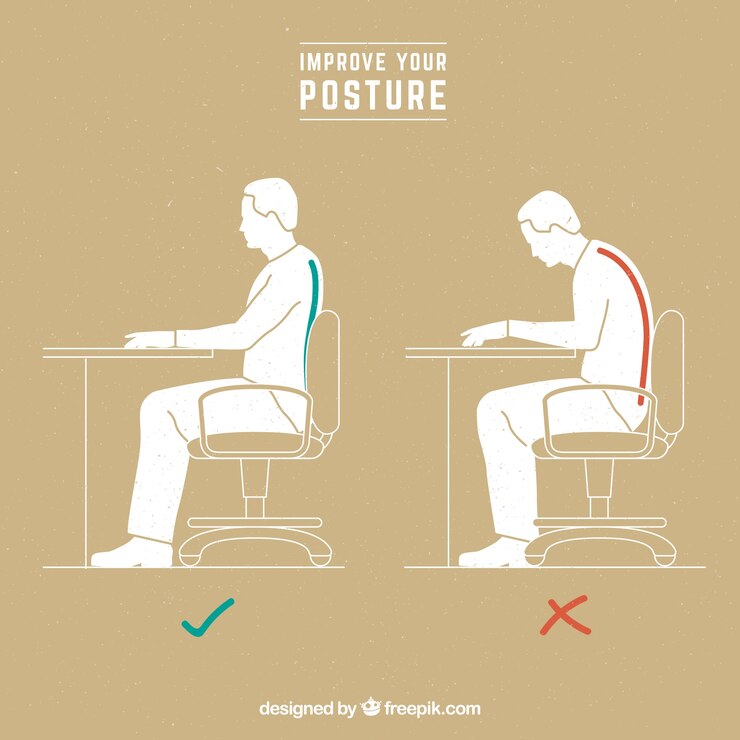Good posture is more than just standing up straight; it’s about maintaining the correct alignment of your body while sitting, standing, or lying down. In this comprehensive guide, we will explore “how to permanently fix posture,” provide “good posture examples,” and delve into “how to have good posture when sitting” or standing. We’ll also highlight the “importance of good posture,” discuss the “5 types of posture,” recommend “good posture exercises,” and even explain “how to fix posture while sleeping.” Along the way, we’ll point out “examples of bad posture” and provide actionable tips to improve your daily habits.
Understanding the Importance of Good Posture
Good posture is essential for:
- Reducing Pain and Discomfort: Proper alignment minimizes strain on your muscles and joints.
- Boosting Confidence: Standing tall exudes self-assurance.
- Improving Breathing: Proper posture ensures your lungs have enough room to expand fully.
- Preventing Injuries: Maintaining correct posture reduces the risk of back pain and repetitive strain injuries.
Maintaining the “importance of good posture” in your daily routine can significantly enhance your quality of life.
5 Types of Posture
Here are the five primary types of posture and their effects:
| Posture Type | Characteristics | Effects |
|---|---|---|
| Ideal Posture | Proper alignment of head, shoulders, and pelvis | Reduced strain, improved balance |
| Kyphosis | Excessive rounding of the upper back | Back pain, rounded shoulders |
| Lordosis | Excessive inward curve of the lower back | Lower back pain, hip discomfort |
| Swayback | Pelvis pushed forward, chest behind hips | Weak core, lower back discomfort |
| Flat Back | Minimal curve in the spine | Fatigue, poor balance |
Understanding these postures helps identify “examples of bad posture” and work towards solutions.
How to Have Good Posture When Sitting
Sitting correctly is crucial, especially for those with desk jobs. Follow these steps to achieve “how to have good posture when sitting”:
- Adjust Your Chair: Keep your feet flat on the floor and knees at a 90-degree angle.
- Support Your Lower Back: Use a cushion or lumbar support.
- Position Your Screen: Your monitor should be at eye level to prevent neck strain.
- Take Breaks: Stand up and stretch every 30 minutes.
Correct Standing Posture
To maintain “correct standing posture”:
- Keep Your Feet Shoulder-Width Apart: Distribute your weight evenly.
- Engage Your Core: Tighten your abdominal muscles.
- Relax Your Shoulders: Keep them back and down.
- Align Your Head: Imagine a string pulling you upward from the top of your head.
How to Fix Posture While Sleeping
Your sleeping position plays a significant role in spinal health. Here’s “how to fix posture while sleeping”:
- Choose the Right Mattress: Opt for a medium-firm mattress to support natural spinal alignment.
- Use Pillows Strategically: Place a pillow under your knees when sleeping on your back or between your knees if you’re a side sleeper.
- Avoid Sleeping on Your Stomach: This position can strain your neck and back.
Good Posture Examples vs. Examples of Bad Posture
| Scenario | Good Posture Examples | Examples of Bad Posture |
| Sitting | Back straight, feet flat on the floor | Slouching, crossing legs |
| Standing | Weight evenly distributed, head aligned | Leaning to one side, protruding hips |
| Walking | Shoulders back, smooth stride | Hunched shoulders, dragging feet |
| Sleeping | Neutral spine, supportive pillow | Twisting spine, head too high or low |
Good Posture Exercises
Incorporating exercises into your routine can help improve posture. Here are some effective “good posture exercises”:
- Plank: Strengthens your core.
- Child’s Pose: Stretches your back and hips.
- Wall Angels: Improves shoulder mobility and posture.
- Cat-Cow Stretch: Enhances spinal flexibility.
- Postural Bracing: Stand against a wall and align your body to practice correct posture.

How to Permanently Fix Posture
Achieving permanent improvements requires consistency and mindfulness. Here’s “how to permanently fix posture”:
- Be Aware: Regularly check your posture throughout the day.
- Strengthen Weak Muscles: Focus on exercises that target your core and back.
- Stretch Tight Areas: Stretch your chest, shoulders, and hip flexors.
- Use Ergonomic Furniture: Invest in supportive chairs and adjustable desks.
- See a Specialist: Consult a physical therapist for personalized advice.
FAQs About Healthy Posture
Q1: How long does it take to fix bad posture? A: With consistent effort, noticeable improvements can occur in 3-6 months, depending on the severity.
Q2: Can wearing posture braces help? A: Yes, they can provide temporary support, but strengthening muscles is crucial for long-term results.
Q3: What are the signs of poor posture? A: Common signs include rounded shoulders, forward head posture, and lower back pain.
Q4: How to have good posture when sitting for long hours? A: Adjust your chair, take breaks, and use a lumbar support cushion.
Q5: What are examples of bad posture? A: Slouching, leaning on one side, and craning your neck forward are typical examples.
By focusing on these tips and recommendations, you can embrace the “importance of good posture” and enjoy a healthier, pain-free life. Remember, maintaining good posture is a lifelong commitment, but the benefits are well worth the effort!


